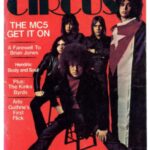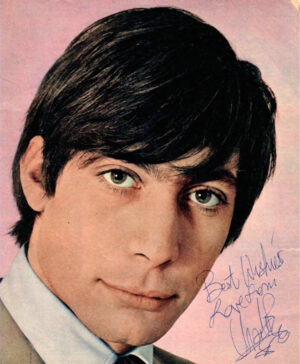-
Featured News
The MC5: A Eulogy
 By Doug Sheppard
And then there were none. Five equals zero. The morning of May 9, 2024, the last surviving member of the MC5, drummer Dennis Thompson, died while recovering from a heart attack—
By Doug Sheppard
And then there were none. Five equals zero. The morning of May 9, 2024, the last surviving member of the MC5, drummer Dennis Thompson, died while recovering from a heart attack— -
Featured Articles
The Beatles: Their Hollywood and Los Angeles Connection
 By Harvey Kubernik
JUST RELEASED are two new installments of the Beatles’ recorded history, revised editions of two compilation albums often seen as the definitive introduction to their work.
Or
By Harvey Kubernik
JUST RELEASED are two new installments of the Beatles’ recorded history, revised editions of two compilation albums often seen as the definitive introduction to their work.
Or -
Ode to a Mensch: Charlie Robert Watts

By Harvey Robert Kubernik
This is not the platform or forum for me to display photos of myself with Charlie Watts or a post card he sent me from the road. However, I feel encouraged by musicians and poets who are offering phone shiva and compelled to write this appreciation.
Charlie was a friend of mine since the early nineties. We never talked about the Rolling Stones. Just jazz.
“One of the great things about recording in Hollywood at RCA was after a session you’d walk into the car port and literally on the other side of the building was [jazz club] Shelly’s Manne-Hole,” Charlie revealed to me at a 2016 Stones’ Coachella Desert Trip tour rehearsal at Third Encore studios in Burbank, California.
In my 2014 book Turn Up The Radio! Pop, Rock, and Roll in Los Angeles 1956-1972 published by Santa Monica Press, I asked Charlie about a Stones’ 1964 or ’65 recording session at RCA.
“While we were recording in Hollywood, I went to Shelly’s Manne-Hole twice—once to see Charles Lloyd, Albert Stinson [with Gabor Szabo and Pete LaRoca], and the Bill Evans Trio with Paul Motian on drums [and Chuck Israels]. I saw Shelly at his club.”
Charlie was always thankful I introduced him to drummer Stan Levey, who he saw in 1960 with Stan Kenton at Wembley. Earlier this century we had lunch at the Levey house in Sherman Oaks and Charlie arrived in a cab from The Four Seasons Hotel in Beverly Hills, wearing perfectly pressed blue jeans, to join Jim Keltner and I.
He relished the Chico Hamilton autograph I personally got for him, and was delighted by the gift I gave him of a Shelley Manne coffee table limited edition book. I fondly recall how Charlie described the thin drum sticks that Shelley used on the bandstand and in the studio. I was a Ludwig 7a wood tip guy.
Charlie supplied a testimonial quote for the back cover for a Buddy Collette album I produced and invited myself, brother Kenneth and Buddy to his big band concert at the Henry Fonda Theater in Hollywood.
Jim Keltner and I later connected Charlie with met drummer Freddie Gruber. Lots of marvelous Buddy Rich and Max Roach tales.
On one Stones’ tour this century, we had a pre-show chat with the legendary drummer Earl Palmer. He had finally met Earl years earlier at The Palace in Hollywood. In the sixties Charlie visited a Phil Spector recording session at Gold Star studio in Hollywood invited by arranger/keyboardist Jack Nitzsche. He loved the Crystals’ record “Da Doo Ron Ron.” Earl or Hal Blaine played drums on the track.
On occasion he referenced his drum set up at Olympic studio in Barnes London, and Sunset Sound and Ocean Way in Hollywood. During 1997 he invited me to a slew of recording sessions at Ocean Way by the Stones during their Bridges to Babylon studio bookings.
There is one memorable Charlie Watts sighting at The Jazz Bakery venue in Culver City when he went to see Elvin Jones. Charlie, in a dashing custom-made suit was greeted and embraced after the show by the drummer drenched in stage sweat. Witnesses knew Charlie wasn’t concerned at all about going to the dry cleaner the next morning.
In 2016 Charlie and Jim Keltner invited me to a Rolling Stones’ rehearsal in North Hollywood. I carried some cymbals into the room with Jim’s lead tech and cartage man that were put on Charlie’s kit. He handed me a tambourine from one cymbal stand that I briefly shook for twenty seconds as the band jammed.
Ronnie Wood saw it and said, “Hey. You’re big time. At our rehearsal. It’s your dream gig? Right?” And I replied, “Yes. But it is not lost on me and just as important is that you were the bass player on Jeff Beck’s Truth LP.”
That blew him away. Keith Richard heard our exchange and laughed out loud. Ronnie hugged me. Then they both handed me their guitar picks.
Charlie smiled…
A couple of years ago I saw Charlie at Don Randi’s Baked Potato club in Studio City. It was an event honoring Hal Blaine on his 90th birthday party. Charlie contributed some autographed drum sticks to a charity auction being held in the room.
Over the last few decades my brother and I would send and give Charlie rare jazz videos. He really dug them. In my last conversation with him, after he visited the Motown Museum in Detroit, Charlie indicated he was building a collection of rare drum items.
May his beat go on and on…
##
I talked to Andrew Loog Oldham in 2014 about Peter Whitehead’s Rolling Stones documentary, Charlie Is My Darling, filmed during the band’s 1965 tour of Ireland.
HK: In 2012 your well-earned original producing credit was officially distributed in the retail and commercial universe by way of Charlie Is My Darling. Can you talk about the genesis of the project? You’ve shown it over the years in related charity functions but now you’ve endorsed and promoted it while it’s achieved stellar notices.
ALO: Yes, it was a Julie Christie world but that is not the origin of the title. It’s the Irish use of it, more soil, more turf, sod of the earth, nothing really sixties about it. The credit is only well earned because I made the movie in the first place. Allen Klein and I had discussed doing it on many occasions, but thankfully nothing happened. There are no accidents—and the timing on this was immaculate.
That end of the sixties is slipping away, soon there will be no more reliable witnesses and this film is a reliable witness. Dylan’s Dont Look Back is a reliable witness. A Hard Day’s Night is not—somebody wrote, constructed and directed that. Charlie Is My Darling is the real deal, the end of the innocence, the last hurrah before what the Beatles had started when they appeared in February of ‘ 64 on The Ed Sullivan Show turned the game into business.
HK: You told me in 2012, “The film was done as an audition to see which one of the Rolling Stones the camera actually loved off stage. We knew who the focus was on stage. The concept was to see who was telegenic off stage. Like an MGM screen test or how studio heads would view talent at RKO. It was Charlie that the camera loved. Ironically, Harvey, is it not the same camera that loved Ringo? There you go.”
My only complaint is that some of the interview footage of Charlie Watts from the original print did not make the new cut of the DVD and new movie. And Charlie is terrific on screen.
ALO: I agree. Charlie was pissed about that as well—or let’s say he noticed it when he was shown the new edit. I wasn’t there, so I don’t know how much he really cared. It was indeed a screen test, done in Ireland so as to be away from journalists, girlfriends and the London life. I just wanted to see whom, off stage, the camera loved. The drummer’s rule, I guess! I thought Charlie looked and sounded terrific. He had the look, he had the voice. I thought he could have a big future in French noir films, but for that to happen somebody else has to agree with you, and they have to be in the French film business.

Charlie Watts (right) with the Rolling Stones at Peter Tork’s house in Los Angeles. October 20, 1969. (Photo by Henry Diltz)

The Rolling Stones at the Forum in Los Angeles, 1973. (Photo by Henry Diltz)